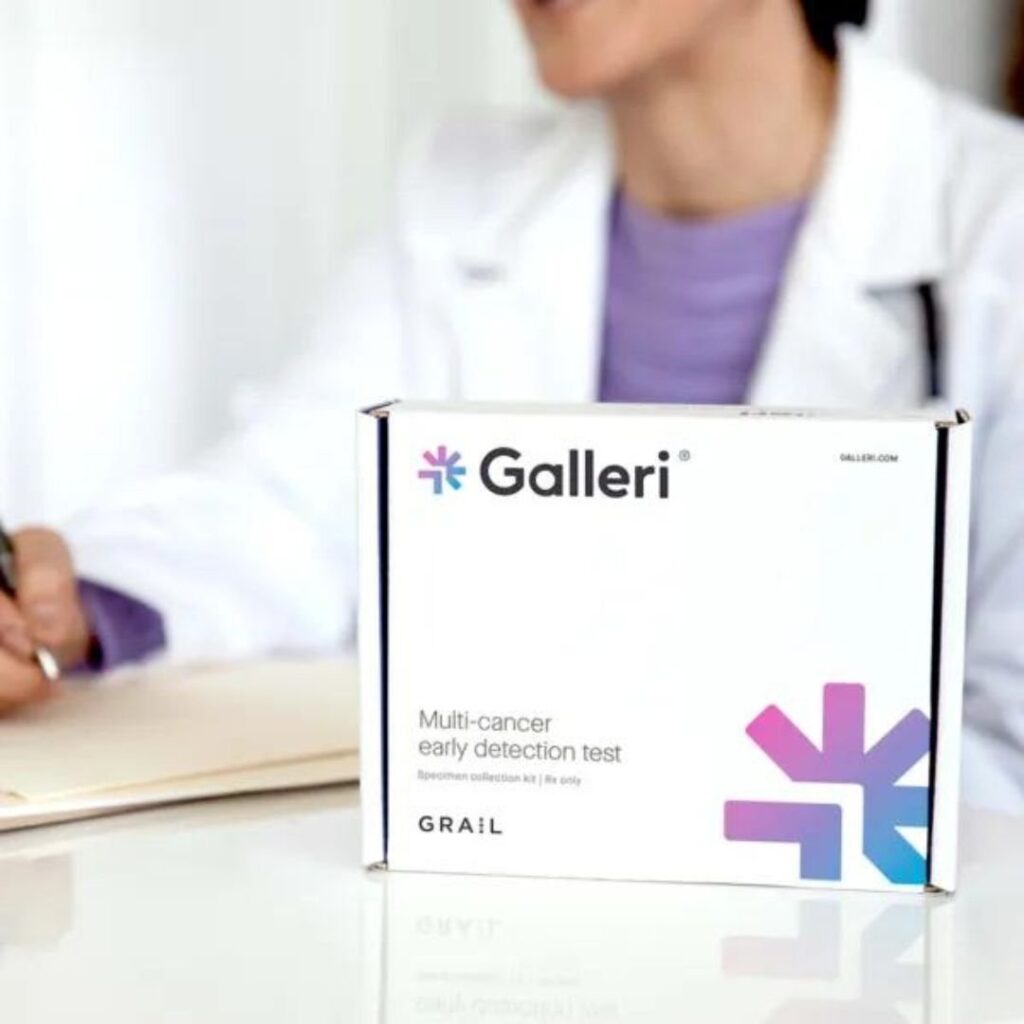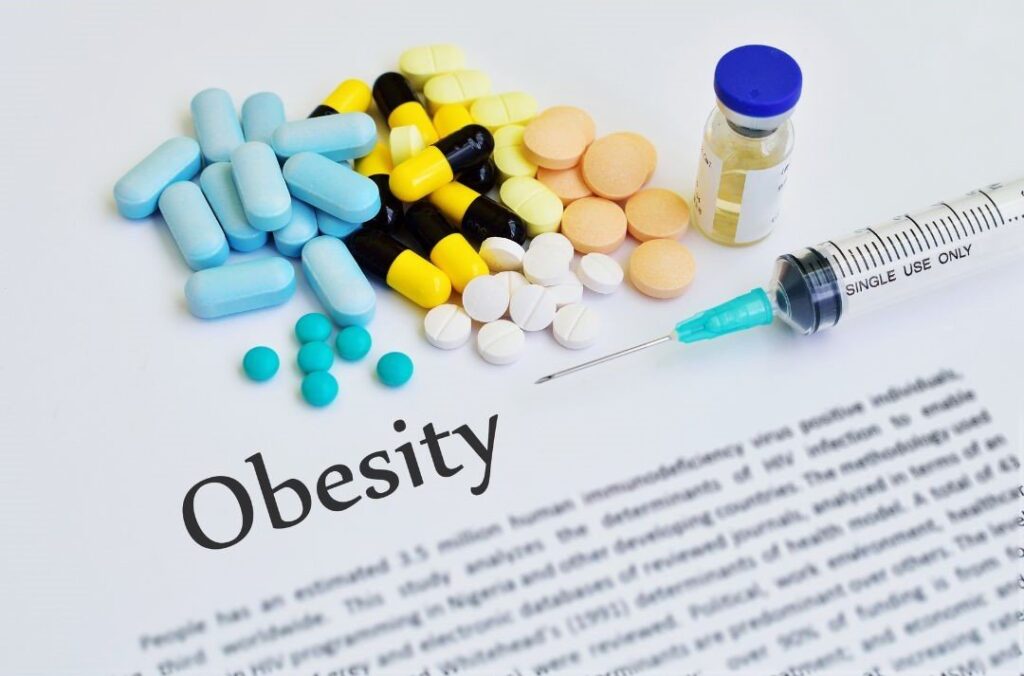How the Grail Galleri Test is Revolutionizing Early Cancer Detection

Hey there, Marqi Health community! Let’s talk about something super important and incredibly exciting in the world of health and wellness – the Grail Galleri test. This is a game-changer when it comes to early cancer detection! Imagine being able to screen for over 50 types of cancer with just a simple blood draw. Yes, you heard that right! article Home Article How the Grail Galleri Test is Revolutionizing Early Cancer Detection Hey there, Marqi Health community! Let’s talk about something super important and incredibly exciting in the world of health and wellness – the Grail Galleri test. This is a game-changer when it comes to early cancer detection! Imagine being able to screen for over 50 types of cancer with just a simple blood draw. Yes, you heard that right! Integrating the Grail Galleri Test into Your Health Routine If you’re considering the Grail Galleri test, here are some tips: Consult Your Healthcare Provider: Discuss whether this test is suitable for you based on your health history and risk factors. Understand the Process: Learn about the test, its benefits, and limitations to make an informed decision. Follow Up: If a cancer signal is detected, work with your healthcare provider to plan the next steps for diagnosis and treatment. What is the Grail Galleri Test? The Grail Galleri test is a revolutionary multi-cancer early detection (MCED) test. Unlike traditional cancer screenings that usually target specific types of cancer, this incredible test can detect over 50 different types of cancer through just a simple blood draw. Yes, you heard that right – one test, over 50 cancers! This means no more multiple appointments and tests for different cancers. The Grail Galleri test makes it so much easier and quicker to get a comprehensive look at your health. It’s like having a superpower in early detection, giving you the chance to catch and address potential issues before they become serious. This test could truly make a huge difference in saving lives by catching cancers early when they are most treatable. How Does the Grail Galleri Test Work? The magic behind the Galleri test lies in its ability to analyse cell-free DNA (cfDNA) in your bloodstream. Here’s a step-by-step look at how it works: Blood Sample Collection: A standard blood sample is taken from your arm. cfDNA Analysis: The sample is analyzed for specific methylation patterns. Methylation is a biological process that can change the activity of a DNA segment without changing its sequence. Cancerous cells have distinct methylation patterns compared to healthy cells. Detection of Cancer Signals:The test identifies abnormal methylation patterns that are indicative of cancer. Identification of Cancer Origin: If a cancer signal is detected, the test can often predict the tissue or organ where the cancer originated. Why is This a Game-Changer? The ability to detect multiple cancers early, often before symptoms appear, is transformative. Early detection is crucial because it increases the chances of successful treatment and survival. Here are some of the key benefits: Early Detection:Identifies cancer at earlier stages when treatment is more likely to be effective. Broad Coverage:Can detect over 50 types of cancer, many of which are not routinely screened for today. Minimally Invasive: Requires only a simple blood draw, making it easier and less invasive than traditional biopsies and imaging tests. Informed Decisions: Helps in planning and making informed treatment decisions sooner. Science-Backed Evidence Research has shown the effectiveness of the Grail Galleri test: Study by Liu et al. (2020): Demonstrated that the Galleri test could detect more than 50 types of cancer with a high specificity (99.3%), meaning there are very few false positives (Liu et al., 2020). Clinical Validation Study (CCGA):Showed that the test could detect cancer signals across various cancer types with a sensitivity that increased with cancer stage (CCGA Consortium, 2020). The Bottom Line The Grail Galleri test offers a promising advancement in early cancer detection, potentially saving lives through early intervention. By detecting cancer early, we can improve treatment outcomes and overall survival rates. Stay informed and proactive about your health with Marqi Health. References: Liu, M. C., et al. (2020). Sensitive and specific multi-cancer detection and localization using methylation signatures in cell-free DNA. Annals of Oncology, 31(6), 745-759. CCGA Consortium (2020). Validation of a ctDNA methylation-based multi-cancer early detection test. Journal of Clinical Oncology, 38(15_suppl), 3049-3049. Related posts
Exercise Smarter, Not Harder: How to Achieve Maximum Results

Ready to unlock the secrets to a healthier, happier you? Let’s dive into why exercise is not just a good idea—it’s essential! Picture this: you’re not just sweating for that summer bod; you’re boosting your heart health, supercharging your brain, and fortifying those muscles and bones. It’s like giving your entire body a VIP pass to the wellness club! article Home Article Exercise Smarter, Not Harder: How to Achieve Maximum Results Why Exercise Matters Regular exercise is a cornerstone of good health, enhancing cardiovascular fitness, mental well-being, and muscle and bone strength. By maintaining a consistent routine and adopting the right approach, such as incorporating aerobic activities, strength training, and flexibility exercises, you can significantly improve your overall wellness. Regular physical activity helps prevent chronic diseases, boosts your mood, and strengthens your body, making it essential for a balanced, healthy lifestyle. Key Principles for Effective Exercise Consistency is Key: Aim for at least 150 minutes of moderate aerobic activity or 75 minutes of vigorous activity each week, combined with muscle-strengthening activities on two or more days. Intensity Matters: Incorporate high-intensity interval training (HIIT) for efficient calorie burning and cardiovascular improvements. Strength Training: Build muscle and boost metabolism by focusing on all major muscle groups at least twice a week. Mix It Up: Combine aerobic, strength, flexibility, and balance exercises for a well-rounded routine. Recovery is Crucial: Prevent injuries and promote continuous improvement by allowing time for rest and recovery. Science-Backed Strategies Interval Training: HIIT can improve cardiovascular health and burn fat more effectively than moderate-intensity continuous training (Gibala et al., 2006). Strength Training: Resistance exercises enhance muscle mass, bone density, and metabolic health (Westcott, 2012). Consistency: Regular exercise reduces the risk of chronic diseases and improves mental health (Warburton et al., 2006). Weekly Workout Routine Monday:HIIT Workout (30 minutes) Warm-up: 5 minutes light jogging Intervals: 30 seconds sprint, 1-minute walk (repeat 10 times) Cool-down: 5 minutes walking and stretching Tuesday:Strength Training (45 minutes) Squats: 3 sets of 12 reps Bench Press: 3 sets of 12 reps Deadlifts: 3 sets of 12 reps Bent-over Rows: 3 sets of 12 reps Plank: 3 sets of 1-minute holds Wednesday:Rest or Light Activity (30 minutes) Yoga or Stretching Thursday:Cardio Workout (45 minutes) Warm-up: 5 minutes brisk walking Steady-state cardio: 35 minutes jogging or cycling Cool-down: 5 minutes walking and stretching Friday:Strength Training (45 minutes) Lunges: 3 sets of 12 reps Overhead Press: 3 sets of 12 reps Pull-ups: 3 sets of 8 reps (use assistance if needed) Dumbbell Rows: 3 sets of 12 reps Russian Twists: 3 sets of 20 reps Saturday:Flexibility and Balance (30 minutes) Dynamic stretches: 10 minutes Balance exercises: 10 minutes (e.g., single-leg stands) Static stretches: 10 minutes Sunday:Rest or Light Activity(30 minutes) Walking or Leisurely Bike Ride By exercising smarter, not harder, you can achieve maximum results with your workouts. Incorporate consistency, intensity, strength training, variety, and recovery into your routine to boost your fitness and health. Stay active and informed with Marqi Health! Practical Tips for Your Routine Set Realistic Goals: Start with achievable targets and gradually increase intensity and duration. Track Progress: Use fitness apps or journals to monitor your workouts and stay motivated. Stay Hydrated: Proper hydration is essential for performance and recovery. Warm Up and Cool Down: Prevent injuries with proper warm-up and cool-down routines. References: Gibala, M. J., et al. (2006). Short-term sprint interval versus traditional endurance training: similar initial adaptations in human skeletal muscle and exercise performance. The Journal of Physiology, 575(3), 901-911. Westcott, W. L. (2012). Resistance training is medicine: effects of strength training on health. Current Sports Medicine Reports, 11(4), 209-216. Warburton, D. E., Nicol, C. W., & Bredin, S. S. (2006). Health benefits of physical activity: the evidence. CMAJ, 174(6), 801-809. Related posts
Hidden Dangers of Cardiovascular Disease: What You Need to Know

Today, we’re diving into cardiovascular disease (CVD) — The number 1 leading cause of death worldwide. Understanding its prevalence, recognizing early signs, and taking preventive measures can make a significant difference in your heart health. Let’s get started! article Home Article Hidden Dangers of Cardiovascular Disease: What You Need to Know Hey there, Marqi Health community! 🌟 Today, we’re diving into cardiovascular disease (CVD) — The number 1 leading cause of death worldwide. Understanding its prevalence, recognising early signs, and taking preventive measures can make a significant difference in your heart health. Let’s get started! Preventive Measures Healthy Diet : Focus on fruits, vegetables, whole grains, lean proteins, and healthy fats. Regular Exercise : Aim for at least 150 minutes of moderate aerobic activity or 75 minutes of vigorous activity each week. Avoid Smoking: Smoking significantly increases the risk of CVD. Limit Alcohol: Drink in moderation to reduce heart disease risk. Manage Stress: Practice stress-reducing techniques like meditation, yoga, or deep breathing exercises. Regular Screenings: Monitor blood pressure, cholesterol levels, and blood sugar regularly. How Prevalent is Cardiovascular Disease? We’re talking about the big, bold reality of heart health, which includes a range of heart and blood vessel disorders like coronary artery disease, heart attacks, and strokes. According to the World Health Organisation, CVD is responsible for about 17.9 million deaths annually, making up 31% of all global deaths. Yep, you read that right—31%! Here in the U.S., it’s a major player, affecting nearly half of all adults. When to Get Checked Out If you experience any of the above symptoms, it’s essential to consult a healthcare provider promptly. Regular check-ups are also crucial, especially if you have risk factors like high blood pressure, high cholesterol, diabetes, obesity, or a family history of heart disease. Early Signs You Should Get Checked Out Recognising the early signs of CVD is crucial for timely intervention and treatment. Here are some symptoms to watch out for: Chest Pain or Discomfort: Often described as pressure, squeezing, or fullness in the chest, this can be a sign of a heart attack or angina. Shortness of Breath: Difficulty breathing during regular activities or at rest can indicate heart problems. Fatigue: Unusual tiredness, especially after physical exertion, might be a sign of heart disease. Irregular Heartbeat: Palpitations or an unusually fast or slow heart rate can signal atrial fibrillation or other heart conditions. Swelling in Legs, Ankles, or Feet : Fluid retention can be a sign of heart failure. Pain in the Neck, Jaw, Throat, or Back: These symptoms, particularly when accompanied by chest pain, should not be ignored. Nausea or Lightheadedness: Feeling faint or lightheaded, especially if accompanied by chest pain or shortness of breath, requires immediate attention. On a Personal Note One of the many reasons I’m so passionate about cardiovascular disease and longevity medicine is because of a personal loss. My friend John, a healthy middle-aged man, passed away suddenly at just 46. His wife left him with their 3 & 5-year-olds to get Tums from the store, and when she returned, she found him on the kitchen floor, gone too soon. This tragedy inspired me to start Marqi. There are too many people like John who need help identifying the early signs of cardiovascular disease. Cardiovascular disease is a serious health concern, but early detection and lifestyle changes can significantly reduce your risk. Stay informed, recognise the signs, and take proactive steps to protect your heart health. References: World Health Organization. (2021). Cardiovascular diseases (CVDs). Retrieved from WHO American Heart Association. (2021). Heart Disease and Stroke Statistics—2021 Update. Retrieved from AHA Related posts
The Truth Behind America’s Obesity Crisis: How Big Healthcare, Big Pharma, and Big Food Profit While We Pay the Price

Over the years, I’ve realized how much our health isn’t just about individual choices, but about the systems surrounding us. As I dug deeper into America’s obesity crisis, I learned that it’s driven by forces much bigger than us—Big Healthcare, Big Pharma, and Big Food. This article, The Truth Behind America’s Obesity Crisis, sheds light on how these industries profit from keeping us sick rather than promoting real health. article Home Article The Truth Behind America’s Obesity Crisis: How Big Healthcare, Big Pharma, and Big Food Profit While We Pay the Price Let’s face it—America is getting fatter, and it’s no accident. The obesity epidemic in the United States is not simply a result of poor personal choices; it’s a byproduct of a system built on profit rather than people. Big Healthcare, Big Pharma, and Big Food have created a vicious cycle where they profit from our illness, not our wellness. We’ve become part of a system that thrives on keeping us sick, making us “consumers” of everything from cheap, unhealthy food to endless medications and expensive healthcare services. Imagine a scenario where the sicker you are, the more valuable you are to these industries. It’s almost like we’re cattle, being fattened up for slaughter, with every pound gained and every pill swallowed adding to the bottom line of these corporations. The relationship between profit and sickness is undeniable—the more we consume, the more they earn. But is there a better way? Yes. The solution lies in a Medicare for All model that incentivises a free-market approach to innovation while still being publicly financed. This shift could turn healthcare from a business of disease management to one of true health promotion. Big Food: Pushing Cheap, Addictive Calories Big Food is in the business of selling calories—preferably ones that are cheap, tasty, and addictive. For decades, food manufacturers have been perfecting the art of making processed foods more palatable and less nutritious. By loading products with sugar, fat, and refined carbohydrates, they create hyper-palatable foods that drive our brain’s reward centres wild. Profiting Off Addiction: The average American consumes 152 pounds of sugar and 133 pounds of flour annually. Processed foods make up about 60% of our calorie intake, and these foods are designed to be addictive【source: Hyman, 2020】. Profiting Off : The overconsumption of these foods contributes directly to the obesity crisis, which in turn drives up rates of type 2 diabetes, heart disease, and cancer. And who benefits from all this? The same food companies that created the problem, along with the healthcare and pharmaceutical industries that get to treat the resulting illnesses. Big Pharma: Profiting From Our Chronic Conditions Pharmaceutical companies don’t make money from healthy people. They profit when we need more pills to manage the consequences of our lifestyle choices, many of which are driven by Big Food’s marketing and product offerings. Treating Symptoms, Not Causes: Drugs for obesity-related conditions like diabetes, hypertension, and heart disease are among the most profitable medications on the market. In 2020 alone, Americans spent over $55 billion on diabetes drugs【source: CDC】. Encouraging Long-Term Dependency: The pharmaceutical industry has little incentive to promote cures. Instead, they develop medications that manage symptoms, often leading to lifelong dependency. From GLP-1 drugs for weight loss to statins for cholesterol, these medications rarely address the root cause—poor nutrition and lifestyle. They simply help people live longer while still being sick. Big Healthcare: The Business of Disease Management Our healthcare system is set up to manage disease, not prevent it. Hospitals and insurance companies generate more revenue when people are admitted for heart attacks, diabetes complications, and other chronic illnesses that are largely preventable. Higher Profits from Sicker Patients: The healthcare industry thrives on high-utilizing patients. The more tests, medications, surgeries, and treatments needed, the more they profit. This creates an inverse relationship: the sicker the population, the higher the healthcare industry’s profits. Reactive, Not Proactive: Most healthcare providers operate on a fee-for-service model, which means they’re compensated based on the volume of services provided, not on improving patient outcomes. This encourages reactive, rather than proactive, care—treating complications rather than preventing them. The Bottom Line: Reclaiming Our Health Americans are not inherently unhealthy—we’ve been manipulated into becoming heavy consumers of the products that make Big Food, Big Pharma, and Big Healthcare rich. The solution isn’t to keep putting band-aids on the problem; it’s to change the system. Medicare for All, combined with incentives for real health outcomes, could be the key to breaking the cycle of profit-driven healthcare. It’s time to move beyond a system that profits from sickness. Let’s create a healthcare system that truly values wellness, prevention, and long-term health. Want to learn more about taking control of your health? Start by taking our free health risk assessment, which can help you understand your current health status and how to make informed, proactive choices for a healthier future. References: Hyman, M. (2020). Food Fix: How to Save Our Health, Our Economy, Our Communities, and Our Planet–One Bite at a Time. CDC. (2020). Diabetes Costs and Spending in the United States. Harvard Public Health Review. (2019). The Role of Big Pharma in the American Obesity Crisis. Sign Up for Our Newsletter Here Ready to take control of your health journey? Sign up for our newsletter to get weekly tips on optimizing your health and longevity with the latest in wearable technology and personalized healthcare. Sign up Thank you! Ops! Something went wrong, please try again. We respect your privacy. You can unsubscribe at any time or update your preferences. References: Hyman, M. (2020). Food Fix: How to Save Our Health, Our Economy, Our Communities, and Our Planet–One Bite at a Time. CDC. (2020). Diabetes Costs and Spending in the United States. Harvard Public Health Review. (2019). The Role of Big Pharma in the American Obesity Crisis. Related posts
Over-Testing vs. Personalized Medicine: Why AI is Shaping the Future of Health Screening

“AI-driven personalized healthcare is transforming medicine, helping us balance early detection with fewer unnecessary tests for improved health outcomes.” article Home Article Over-Testing vs. Personalized Medicine: Why AI is Shaping the Future of Health Screening In healthcare, one of the longest-running debates has been about under-testing versus over-testing. Should we proactively screen for every potential health risk, or should we be more selective, focusing on specific markers and personalised needs? The stakes are high, with implications for patient well-being, healthcare costs, and outcomes. While over-testing can lead to unnecessary treatments and anxiety, under-testing risks missing critical warning signs. In the past, generalized testing may have been beneficial simply because we lacked precise tools to narrow our focus. But today, thanks to AI-driven algorithms and an ever-expanding pool of health data, we can make more informed decisions about what tests matter most, for whom, and when. This shift toward personalised medicine is proving that one-size-fits-all testing is no longer the only option—or the best one. The Downsides of Over-Testing: False Positives and Unnecessary Interventions While the intention behind extensive testing is often preventive, over-testing can have unintended consequences, particularly when it results in false positives. False positives can lead to unnecessary follow-up tests, invasive procedures, and even treatments that may not improve patient outcomes and might lower quality of life instead. For instance, research published in JAMA Internal Medicine highlighted that over-screening for certain cancers, like prostate and thyroid cancer, can lead to overtreatment without significant improvements in survival rates. The psychological impact of false positives is also significant. When a test shows a potential health issue, even if later ruled out, it creates anxiety and stress for patients. These “unnecessary alarms” can divert attention from actual health needs and lead to an over-medicalised lifestyle that detracts from a person’s quality of life. Cost-Effectiveness and Resource Efficiency: The Value of Targeted Testing From a financial and resource efficiency standpoint, over-testing comes at a high cost. According to the British Medical Journal, healthcare systems could achieve greater cost-effectiveness by focusing on tests that have a high predictive value and that target common, impactful conditions. The idea here is to invest in preventive measures and screenings for high-risk populations rather than performing blanket tests on low-risk individuals. Resource efficiency isn’t just about saving money; it’s about using resources in a way that maximises benefits for the population. For example, prioritising routine testing for individuals with a strong family history of specific diseases, or focusing on biomarker tests for individuals with genetic predispositions, can produce far more meaningful results than indiscriminate screening. The AI Advantage: Precision Testing with Big Data and Predictive Analytics This is where AI comes in. We now have access to more data than ever before in human history, and AI has transformed how we interpret it. Using AI algorithms in personalised medicine allows us to analyse vast amounts of health data, predict trends, and identify risks with a level of accuracy that wasn’t previously possible. Organisations like Marqi Medical are at the forefront, leveraging AI-driven approaches to personalise testing strategies. By incorporating factors such as genetics, lifestyle, personal and family health history, and other biomarkers, AI enables healthcare providers to tailor testing schedules based on the unique needs of each individual. This precision testing approach significantly reduces the risk of false positives and ensures that testing resources are focused on where they’re most needed. Personalized Testing: Balancing Risk and Benefit for Better Health Outcomes Research increasingly supports a personalised testing approach, which balances the need for preventive care with the potential downsides of over-testing. For example, the U.S. Preventive Services Task Force recommends avoiding routine screenings for low-risk individuals in cases where it does not compromise health outcomes. By focusing on high-risk individuals and utilising advanced screening techniques, we’re not only improving health outcomes but also reducing unnecessary healthcare costs and avoiding procedures that may not be beneficial. Personalised algorithms consider specific health factors to determine the most relevant and timely tests, optimising the use of healthcare resources and improving patient satisfaction by avoiding needless interventions. Quality of Life and Longevity: How Personalized Testing Can Enhance Both A well-validated personalised testing approach does more than just detect potential diseases—it has the potential to enhance both longevity and quality of life. A study published in The Lancet highlighted that personalised testing helps to identify and address specific health risks before they manifest as chronic diseases, significantly improving life quality in the process. On the other hand, generalized over-testing can lead to “over-medicalization,” where individuals are so focused on managing false positives and incidental findings that their overall well-being suffers. By prioritizing targeted testing based on individual profiles, we can avoid this pitfall, ensuring that medical interventions enhance life quality rather than detract from it. Conclusion: The Future Lies in AI-Driven, Personalized Testing The debate on under-testing versus over-testing no longer needs to be a choice between two extremes. AI and personalised medicine allow us to balance the benefits of early detection with the potential drawbacks of unnecessary testing. With these tools, we can create a healthcare approach that is proactive, efficient, and individualised. As we continue to refine our understanding of how genetics, lifestyle, and environmental factors influence health, the future of healthcare lies in tailoring interventions to each unique individual. A personalised testing strategy doesn’t just maximise benefits and reduce unnecessary procedures—it has the potential to optimise both longevity and quality of life. If you’re ready to take charge of your health in a personalised, data-driven way, start by taking our free health risk assessment. Learn how Marqi Medical uses advanced technology and AI to create customised health plans that meet your unique needs. References: JAMA Internal Medicine. (Year). Title of Study on False Positives and Over-Screening. British Medical Journal. (Year). Title of Study on Cost-Effectiveness of Targeted Testing. U.S. Preventive Services Task Force. (Year). Title of Recommendation on Testing for Low-Risk Populations. The Lancet. (Year). Title of Study on Quality of Life and Personalized Testing. Sign Up for Our Newsletter Here Ready to take control of your health journey? Sign up for our newsletter to get weekly tips on optimising your health and longevity with the latest in wearable technology and
Personalized Cancer Prevention: How Early Detection and Expert Guidance Can Maximize Health and Peace of Mind

“Personalized cancer prevention promotes early detection and guides you through treatment options, maximizing health and peace of mind.” article Home Article Personalized Cancer Prevention: How Early Detection and Expert Guidance Can Maximize Health and Peace of Mind Cancer is a disease that touches nearly every family in some way, and as our understanding of cancer evolves, so do the tools available to detect, prevent, and manage it. Whether it’s focusing on early detection or navigating the complexities of treatment, there’s a lot to consider. In this article, we’ll dive into key aspects of cancer prevention and offer a roadmap for navigating the healthcare system if you or a loved one faces a diagnosis. Key Takeaways Cancer Prevalence:Understand the scope of cancer in the U.S., along with key risk factors to stay informed. Proactive Testing: Learn the importance of regular, advanced screenings to catch cancer early and improve outcomes. Prevention Focus: Practical, actionable steps you can take now to lower your cancer risk. Navigating Care: Strategies for finding the right specialists, accessing the latest treatments, and exploring clinical trials post-diagnosis. Proactive Testing: Importance of Regular, Advanced Screenings Early detection is critical in improving cancer outcomes. Regular screenings, particularly advanced and personalised tests, help catch cancers at an early, more treatable stage. While standard screenings like mammograms, colonoscopies, and PSA tests are essential, newer, more advanced testing options can provide even deeper insights: Genetic Testing: For those with a family history of cancer, genetic testing can identify specific mutations, such as BRCA1 or BRCA2, that signal a higher risk for breast and ovarian cancers. Biomarker and Blood Tests:Advanced blood panels and biomarker tests can detect changes indicative of cancer before symptoms arise. Imaging Advances: Full-body MRIs and other imaging techniques can identify abnormalities that traditional imaging may miss. Studies show that early detection often leads to a 90% survival rate for many cancers, particularly when tumours are small and haven’t yet spread. If you have a family history or other high-risk factors, talk to your healthcare provider about more frequent or specialised screenings. Prevention Focus: Practical Steps to Lower Cancer Risk While some cancer risk factors cannot be changed, many are within our control. Executives and busy professionals, in particular, often face heightened stress and lifestyle factors that can contribute to risk. Here are several steps you can take to lower your cancer risk: Healthy Diet: Aim for a plant-forward diet rich in antioxidants, fiber, and nutrients. Foods like leafy greens, berries, nuts, and lean proteins provide cancer-fighting properties. Exercise Regularly: Consistent exercise has been shown to reduce the risk of several cancers, particularly breast, colon, and lung cancers. Limit Alcohol and Avoid Tobacco: Alcohol and tobacco are both linked to multiple cancer types. Cutting back or eliminating these from your lifestyle reduces your risk significantly. Reduce Environmental Toxins: Be mindful of potential carcinogens in the workplace, home, and even personal care products. Choosing safer alternatives where possible can make a difference. Manage Stress: Chronic stress can weaken the immune system, so implementing stress-reducing practices like meditation, exercise, and adequate sleep is essential. Focusing on these preventive measures not only lowers cancer risk but improves overall well-being and quality of life. Cancer Prevalence: Awareness of Cancer Statistics and Risk Factors Cancer affects millions in the U.S. alone, with approximately 1.9 million new cases diagnosed each year. The likelihood of someone developing cancer in their lifetime is that approximately 1 in 2 men and 1 in 3 women in the United States will be diagnosed with cancer at some point during their lives. This translates to a roughly 40% overall lifetime risk for Americans, While certain types of cancer can be attributed to genetic factors, lifestyle and environmental exposures also play a significant role. Knowing your risk factors—whether they be genetic, lifestyle-based, or environmental—can provide a clearer roadmap to preventive care. Key risk factors include: Genetic Predisposition: Family history of cancer can significantly increase risk. Lifestyle Choices: Tobacco use, alcohol consumption, poor diet, and lack of exercise are associated with various cancers. Environmental Exposures: Certain pollutants, UV radiation, and occupational hazards increase cancer risk. Understanding these factors empowers individuals to make informed choices, and for those at high risk, proactive prevention and testing are especially important. How AI is Transforming Preventive Healthcare If faced with a cancer diagnosis, navigating the healthcare system can be overwhelming. Here are some strategies to make the journey a bit more manageable: Understanding Treatment Options Standard Treatments vs. New Innovations: Traditional treatments such as surgery, radiation, and chemotherapy are evolving. Ask your specialist about emerging therapies like immunotherapy or precision medicine that target specific mutations in cancer cells. Clinical Trials: Clinical trials offer access to cutting-edge treatments not yet widely available. For some, trials provide a lifeline to experimental therapies when standard options are limited. Organizations like the National Cancer Institute and ClinicalTrials.gov provide databases of ongoing trials across the country. Building a Support Network Emotional Support: Cancer can be emotionally taxing. Seek support through family, friends, or support groups to ease the emotional strain. Patient Advocates: Many cancer centers have patient advocates who can help with logistics, insurance questions, and understanding treatment options. They’re invaluable resources during a challenging time. Choosing the Right Specialists Oncologist Selection: Start with an oncologist specializing in your type of cancer. Specialized knowledge is crucial for effective treatment and guidance on available therapies. Multidisciplinary Approach: Cancer often requires a team approach, so look for healthcare centers with a collaborative, multidisciplinary team that includes surgeons, radiologists, nutritionists, and mental health professionals. Second Opinions: Don’t hesitate to seek second opinions, particularly if you’re uncertain about the recommended course of treatment. Conclusion: A Proactive, Informed Approach to Cancer Prevention and Care In today’s healthcare landscape, we have access to advanced testing, personalised prevention strategies, and an array of treatment options that previous generations did not. Taking advantage of these resources can make a profound difference in cancer outcomes. By focusing on awareness, prevention, and early detection, and by knowing how to navigate the system post-diagnosis, you can make the most informed
The Revolutionary Power of Age Clocks: Extending Life, Health, and Transforming Healthcare

“Age clocks are transforming how we age—offering early detection, personalized insights, and the power to extend both health and life spans.” article Home Article The Revolutionary Power of Age Clocks: Extending Life, Health, and Transforming Healthcare Ageing—it’s the one journey we all share, yet no two paths are the same. That’s where age clocks come in. These cutting-edge tools are redefining how we understand ageing by measuring your biological age (how old your body actually is) versus your chronological age (how many candles are on your birthday cake). By leveraging biomarkers, advanced imaging, and AI-driven analytics, age clocks are revolutionising healthcare, empowering us to take control of our health spans (how long we stay healthy) and life spans (how long we live). But their impact doesn’t stop at the individual—they’re also reshaping the entire healthcare industry. Key Takeaways Personalized Health Insights: Age clocks reveal how your body is aging at the cellular and organ level, providing actionable data. Proactive Health Management: Early detection of biological aging allows for targeted interventions to slow down or even reverse aging-related decline. Healthcare Transformation: From lowering system costs to redefining insurance models, age clocks are changing the way we approach health on a systemic level. The Future of Age Clocks: What’s Next? Integration with AI Platforms Unified systems will aggregate data from wearables, biomarkers, and imaging, offering real-time insights into ageing and health optimisation. Scaling Access Making age clocks more cost-effective and widely available will democratize access to longevity tools, enabling more people to take control of their health. Advancing Research Ongoing studies in epigenetics, machine learning, and bioinformatics will refine the accuracy and applicability of age clocks, opening new doors for personalised healthcare. The Science Behind Age Clocks: How They Work Age clocks combine science and technology to analyze how your body is aging. Here are some of the key advancements: Avoid "Saving Calories" Devices like the Apple Watch, Oura Ring, and WHOOP track metrics like heart rate variability, sleep quality, and activity levels, correlating them with your biological age. These tools help connect daily lifestyle choices—like sleep and exercise—with their long-term impact on aging. Epigenetic Clocks Tools like the Horvath Clock and GrimAge analyze changes in your DNA methylation—chemical tags that accumulate as you age. Newer models like PhenoAge go a step further, integrating physiological markers to predict the onset of chronic diseases and even your risk of mortality. AI and Machine Learning AI-powered algorithms analyze data from wearables, biomarkers, and imaging to refine age estimates and predict health trajectories. These models aren’t just looking at static data—they’re learning, evolving, and getting smarter with each new input. Wearable and Real-Time Monitoring Devices like the Apple Watch, Oura Ring, and WHOOP track metrics like heart rate variability, sleep quality, and activity levels, correlating them with your biological age. These tools help connect daily lifestyle choices—like sleep and exercise—with their long-term impact on aging. Imaging-Based Age Clocks Advanced imaging like MRI, DEXA scans, and CT scans measure organ-specific aging. For instance, they can detect brain atrophy or cardiovascular calcification, offering precise insights into how specific systems are aging. Impact on Life Span and Health Span: Why It Matters Extending Health Span Early detection of biological ageing allows for interventions that delay the onset of age-related diseases. Personalised recommendations—ranging from dietary adjustments to exercise regimens—optimise your quality of life and keep you healthy longer. Increasing Life Span Preventive measures, guided by age clock insights, can slow biological ageing and potentially add years to your life. Strategies like boosting hormone production, NAD+ levels, incorporating senolytics (drugs that target ageing cells), or tailoring your supplement regimen to your biology are far more effective when aligned with precise data. Proactive Health Management Age clocks shift healthcare from reactive (treating diseases after they occur) to proactive (preventing them before they happen). They empower individuals to monitor their ageing trajectory and make adjustments, giving them control over their health journey.. The Science Behind Age Clocks: How They Work Age clocks combine science and technology to analyze how your body is aging. Here are some of the key advancements: Personalized and Preventive Healthcare Age clocks enable healthcare providers to deliver precision medicine, tailoring interventions to individual aging profiles. By identifying risk factors early, they reduce the burden of chronic diseases, improving both outcomes and efficiency. Cost Savings for Health Systems Delaying the onset of age-related diseases reduces hospitalizations and expensive treatments. For example, detecting cardiovascular aging early could avoid costly surgeries and complications down the road. Preventive measures guided by age clocks translate to significant long-term savings for healthcare providers and patients alike. Redefining Insurance Models Insurers can use biological age metrics to design data-driven policies, offering lower premiums to individuals who take proactive steps to improve their health. This approach incentivizes healthy behaviors, reducing overall claims and improving underwriting accuracy. Corporate Wellness Programs Employers are integrating age clocks into wellness initiatives to boost employee productivity and longevity. These programs foster a culture of well-being, reducing absenteeism and healthcare costs while improving employee satisfaction. Conclusion: Redefining the Way We Age Age clocks are more than just tools—they’re a revolution in how we perceive and manage ageing. By enabling early detection, personalised interventions, and a proactive approach to health, these advancements promise to extend our health spans, improve our life spans, and transform healthcare systems. At Marqi Medical, we’re proud to be at the forefront of this evolution. By combining cutting-edge technology with personalised care, we’re empowering individuals to take charge of their health journey and redefine what ageing looks like. Sign Up for Our Newsletter Here Ready to take control of your health journey? Sign up for our newsletter to get weekly tips on optimizing your health and longevity with the latest in wearable technology and personalized healthcare. Sign up Thank you! Ops! Something went wrong, please try again. Related posts
Struggling with Weight Despite Doing Everything Right? Uncover the Root Cause to What’s REALLY Holding You Back

“Struggling with weight despite doing everything right? The key to lasting change lies in uncovering the root causes—not just the symptoms.” article Home Article Struggling with Weight Despite Doing Everything Right? Uncover the Root Cause to What’s REALLY Holding You Back Let’s be real—weight management isn’t easy. It’s a deeply personal battle that millions of Americans face every day, including me. As the leader of Marqi Medical, I feel a profound responsibility to live by the values we promote. Yet here I am, facing my own challenge: I’m medically considered obese, with a body fat percentage of 30%, trending in the wrong direction. I exercise regularly, eat well, and keep my alcohol intake in check, yet something isn’t clicking. I suspect deeper factors—hormonal imbalances, food sensitivities, a sedentary work schedule, stress, and lack of sleep—are at play. This is a wake-up call for me, but it’s also a shared reality for many of you. So, I’ve decided to document my journey, not just for myself, but for my family, our community, and anyone else searching for answers. I’m all-in. Over the weekend, I took my “before” photos and am diving deep into the root causes of my weight struggles. Along the way, I’m exploring solutions that go beyond the obvious—solutions that combine science, innovation, and actionable insights. Key Takeaways Obesity in America: Nearly 42% of adults are obese, with countless others struggling with excess weight. Obesity is linked to conditions like heart disease, diabetes, and cancer. Beyond the Basics: While diet, exercise, and sleep are critical, innovative strategies like hormonal optimization, gut health, and advanced metabolic testing can make all the difference. The Root Cause Approach: Understanding the “why” behind weight gain—whether hormonal imbalances, metabolic inefficiencies, or food sensitivities—is the key to lasting change. A Path Forward: Explore scientifically validated strategies, including targeted testing, advanced therapies, and personalized interventions, to reclaim your health. Proposed Solutions: The Cutting Edge of Weight Loss While diet, exercise, and sleep form the foundation of health, let’s explore scientifically validated strategies that address the root causes of weight struggles. Why This Matters to Everyone My story is just one example, but the truth is, obesity doesn’t discriminate. It affects busy professionals, parents, retirees—anyone. The ripple effects extend beyond personal health to relationships, productivity, and healthcare costs. But there’s hope. By taking a personalised, science-backed approach, we can turn the tide. Join Me on This Journey I’m committing to understanding my own root causes and taking proactive steps to regain control of my health. Over the next few months, I’ll share updates on my progress—what’s working, what’s not, and the lessons learned along the way. If you feel stuck, frustrated, or just curious, I invite you to join me. Start by exploring the root causes of your weight challenges with targeted testing and personalised strategies. This isn’t just about losing weight—it’s about gaining confidence, energy, and control. Obesity in America: A Growing Epidemic Did you know that nearly 1 in 2 adults in the U.S. will struggle with obesity during their lifetime? According to the CDC, over 42% of adults are classified as obese. This isn’t just about numbers on a scale—it’s about what they represent. Obesity is a significant risk factor for: Heart Disease: The leading cause of death in the U.S. Type 2 Diabetes: A chronic condition affecting 37.3 million Americans. Cancer: Obesity is linked to at least 13 types of cancer. Mental Health Issues: Depression, anxiety, and stigma often accompany weight struggles. What’s more alarming? Obesity-related healthcare costs top $173 billion annually in the U.S., a figure that highlights the systemic nature of this crisis. Proposed Solutions: The Cutting Edge of Weight Loss While diet, exercise, and sleep form the foundation of health, let’s explore scientifically validated strategies that address the root causes of weight struggles. Hormonal Optimization What to Test: Thyroid panel, testosterone levels, and cortisol. Solutions: Thyroid Hormone Therapy: Balances metabolism for those with hypothyroidism Testosterone Replacement Therapy (TRT): Reduces fat and increases lean muscle. Stress Reduction: Adaptogens like ashwagandha help regulate cortisol. Metabolic Optimization What to Test: Fasting glucose, insulin, HbA1c, and NAD+ levels. Solutions: Berberine: A natural insulin sensitizer with effects similar to metformin. NAD+ Boosters: Improve mitochondrial function and energy production. Green Tea Extract: Enhances thermogenesis and fat oxidation. Gut Health and Detox What to Test: Comprehensive stool analysis and food sensitivity panels. Solutions: Probiotics: Strains like Lactobacillus gasseri reduce visceral fat. Prebiotics: Support a balanced gut microbiome. Detox Supplements: Advanced Therapies Cold Exposure: Activates brown fat to burn calories. Peptide Therapy: Enhances growth hormone release to improve fat metabolism. Join Me This Holiday Season Let’s do this together. Start by taking our free AI-driven health risk assessment to uncover what’s holding you back. It’s time to take control of your health journey. Learn More Related posts
How to Avoid Holiday Weight Gain Without Sacrificing Your Favorite Foods

Thanksgiving dinner can pack 4,500 calories—but with mindful choices, you can enjoy the holidays without compromising your health goals article Home Article How to Avoid Holiday Weight Gain Without Sacrificing Your Favorite Foods Let’s be honest—holidays are an indulgent time of year. Thanksgiving dinner alone can set you back 3,000 to 4,500 calories, not including the snacks, drinks, and desserts that fill the day. By the time the season is over, the average American gains 2 to 5 pounds, according to research in the New England Journal of Medicine. It might not sound like much, but over the years, this weight can add up, contributing to long-term health challenges. This year, I’m taking a different approach—not just for me, but for everyone who struggles to balance indulgence and health during the holidays. Here’s what I’ve learned, my strategies for navigating the season, and what science says about managing those tempting holiday feasts. Key Takeaways Calories Add Up Quickly: A single holiday meal can contain more than double the calories most people need to maintain their weight. The Long-Term Impact: While the average holiday weight gain is modest, it often isn’t lost, leading to gradual weight increases over time. Mindful Strategies Work: Simple techniques like portion control, staying active, and mindful eating can significantly reduce the risk of overindulgence. The Numbers Don’t Lie: Thanksgiving by the Numbers On average, Americans consume: 3,000 to 4,500 calories during Thanksgiving dinner. Over 5,000 calories when factoring in drinks, snacks, and other meals. To put this in perspective: A sedentary woman typically needs 1,600–2,000 calories/day to maintain her weight. A sedentary man needs 2,000–2,400 calories/day. Consuming 5,000 calories in a single day creates a caloric surplus of 3,000 calories for many people, which translates to nearly 1 pound of fat. Add this to a series of holiday meals, and the weight gain becomes significant. Why This Matters to Everyone Weight gain isn’t just about aesthetics—it’s about health. Obesity rates in America have skyrocketed, with over 42% of adults classified as obese. This contributes to: Heart Disease: The leading cause of death in the U.S. Type 2 Diabetes: Affects 37.3 million Americans. Cancer: Linked to 13 different types, including breast and colorectal cancer. For me, the holidays often meant indulging guilt-free. But as I’ve become more aware of my health—and the challenges of managing weight—I’ve realised the importance of balance. This season, I’m focusing on strategies that let me enjoy the festivities without sacrificing my health goals. What Happens If You Overindulge? It’s easy to feel guilty after a day of feasting, but remember: Immediate weight gain is mostly water weight and glycogen storage , not fat. 1 pound of fat = 3,500 calories. A single day of indulgence might not ruin your progress, but consecutive days without balance can add up. The key is getting back on track with your next meal. Don’t let one meal spiral into a season-long setback The Bottom Line: Enjoy, Don’t Overindulge The holidays are about celebrating with loved ones, not counting calories. By making mindful choices and incorporating simple strategies, it’s possible to enjoy the season without compromising your health goals. This year, I’m focusing on progress, not perfection. I’m giving myself grace while committing to a healthier, more balanced approach to the holidays. If you’re on the same journey, know that you’re not alone, and every mindful choice adds up. A Personal Plan: Staying on Track During the Holidays Here’s what I’m doing differently this year—and what you can try, too Plan Active Festivities Whether it’s a family walk after dinner or a morning workout, staying active helps offset some of the indulgence. This is a big part of my routine, whether it’s a turkey trout or an intense workout at the gym, those extra calories can be used as muscle fuel, instead of extra fat storage. Be Mindful of Portions Instead of loading up my plate with everything in sight, I’m sampling small portions of my favourites. Using a smaller plate has helped me avoid overindulging without feeling deprived. Hydration Before Indulgence Water is my secret weapon. Staying hydrated throughout the day curbs hunger and keeps my brain from mistaking thirst for cravings. I also limit sugary drinks and stick to sparkling water or light cocktails. Avoid “Saving Calories” Skipping meals before a big feast often backfires. Eating a protein-packed snack, or a tall glass of water, before heading to the table helps me make better choices and prevents overeating. Manage Stress and Sleep Holiday stress and late nights can wreak havoc on hunger hormones. Prioritising 7–8 hours of sleep and practising mindfulness keeps me grounded and less likely to stress-eat. How AI is Transforming Preventive Healthcare Choose Your Indulgences Wisely Three-Bite Rule: Enjoy three mindful bites of your favorite treat, then stop. You’ll savor the flavors without overdoing it. Focus on Protein and Veggies First: Fill half your plate with lean turkey and greens before diving into the starchy sides. Eat Slowly It takes about 20 minutes for your brain to register fullness. Savoring each bite not only enhances the meal experience but helps prevent overeating. Don’t Graze Mindless grazing at buffets or snack tables can quickly add up. Plate your food to keep track of how much you’re eating. Keep Moving Daily activity—even a brisk 30-minute walk—can make a big difference. Studies show that consistent movement during the holidays helps maintain weight and reduce stress. Join Me This Holiday Season Let’s navigate the holidays together. Whether you’re aiming to maintain your weight, improve your habits, or simply enjoy the season without guilt, there’s a path forward. Take our free AI-driven health risk assessment to uncover what’s holding you back and get personalized strategies for a healthier you. Learn More Marqi Medical—Age on Your Terms. Related posts
Top 5 Warning Signs You Shouldn’t Ignore: Insights from Marqi Medical

At Marqi Medical, we combine data from wearables, imaging, bloodwork, and genomics to provide a comprehensive view of your health. Our goal is to empower you to take proactive steps that keep you healthy, active, and thriving. Don’t ignore the signs—listen to your body and act now. article Home Article Top 5 Warning Signs You Shouldn’t Ignore: Insights from Marqi Medical Sometimes, your body whispers before it shouts. Subtle changes in your health can be easy to brush off, especially when life gets busy. But at Marqi Medical, we’ve seen firsthand how ignoring these early signals can lead to serious consequences. That’s why understanding and acting on warning signs is a cornerstone of our proactive, AI-driven approach to healthcare. These aren’t just symptoms—they’re opportunities to intervene early, prevent chronic conditions, and stay ahead of potential health risks. Key Takeaways Early Detection Saves Lives: Subtle symptoms often point to deeper, underlying issues that can be addressed before they escalate. Data Tells the Story:Combining advanced diagnostics, AI, and wearable technology can uncover hidden health risks. Don’t Ignore These Signs: From persistent fatigue to sudden weight changes, learn what your body is trying to tell you. Proactive Care Matters: Addressing these warning signs early can prevent costly and life-altering health problems. Why Acting Early Matters Ignoring these warning signs doesn’t make them go away. In fact: Heart Disease: Early symptoms like fatigue or shortness of breath often precede serious events like heart attacks. Cancer: Detecting abnormalities via imaging before symptoms appear can increase survival rates by up to 90%. Chronic Conditions: Intervening early in conditions like diabetes or autoimmune disorders can drastically improve quality of life and reduce healthcare costs. By leveraging AI and cutting-edge diagnostics, Marqi Medical helps you take action before these signs become life-altering problems. A Personal Perspective Let me share a story about one of our members, Sarah. She’s a 42-year-old working mom who felt constantly fatigued and brushed it off as part of her busy life. When her weight started fluctuating, she reached out to us. Through advanced testing, we discovered she had undiagnosed Hashimoto’s thyroiditis and insulin resistance—two issues that, if left unchecked, could have led to diabetes and heart complications. With a personalised care plan, Sarah now has her energy back and is living a healthier, more balanced life. The Top 5 Warning Signs to Watch For Persistent Fatigue We all feel tired from time to time, but if you’re dragging even after a full night’s sleep, it could be a red flag. What It Could Mean: Hormonal imbalances like thyroid dysfunction, nutrient deficiencies (e.g., iron or B12), or chronic conditions such as sleep apnea. Marqi Medical’s Approach: Advanced bloodwork can uncover deficiencies, while wearables like sleep trackers pinpoint sleep quality issues. Unexplained Weight Changes Sudden weight gain or loss without a change in diet or activity can signal trouble. What It Could Mean: Issues like insulin resistance, hormonal imbalances, or even early signs of cancer. Marqi Medical’s Approach: We combine metabolic testing, gut health panels, and imaging to uncover root cause of weight fluctuations. Changes in Heart Rate or Breathing Feeling your heart race unexpectedly or experiencing shortness of breath? Don’t ignore it. What It Could Mean: These could indicate cardiovascular issues or arrhythmias. Marqi Medical’s Approach: Wearables like Apple Watches and advanced imaging tools like CT scans detect abnormalities in heart health early. Persistent Pain or Unusual Symptoms Whether it’s a nagging headache, joint pain, or a random tingling sensation, don’t dismiss these as minor nuisances. What It Could Mean: Chronic pain could stem from inflammation, autoimmune disorders, or even early signs of neurological issues. Marqi Medical’s Approach: Using AI analyze imaging, and wearables, we correlate symptoms to uncover and address root cause. Frequent Digestive Issues Feeling your heart race unexpectedly or experiencing shortness of breath? Don’t ignore it. What It Could Mean: Conditions like IBS, food sensitivities, or inflammation in the gut. Marqi Medical’s Approach: Our advanced gut health panels can identify underlying inflammation, dysbiosis, or food triggers that need addressing. Proactive Steps You Can Take Today If you’ve experienced any of these symptoms, don’t wait. Here’s what you can do now: Track Your Symptoms Use a journal or wearable device to monitor how you’re feeling daily. Get Tested Talk to your doctor about blood panels, imaging, and advanced diagnostics tailored to your needs. Take Our Free Health Risk Assessment Marqi Medical’s AI-driven assessment helps identify your risks and creates a personalised plan for you. Take Control of Your Health with Marqi Medical At Marqi Medical, we combine data from wearables, imaging, bloodwork, and genomics to provide a comprehensive view of your health. Our goal is to empower you to take proactive steps that keep you healthy, active, and thriving. Don’t ignore the signs—listen to your body and act now. Learn More Marqi Medical—Age on Your Terms. Related posts
